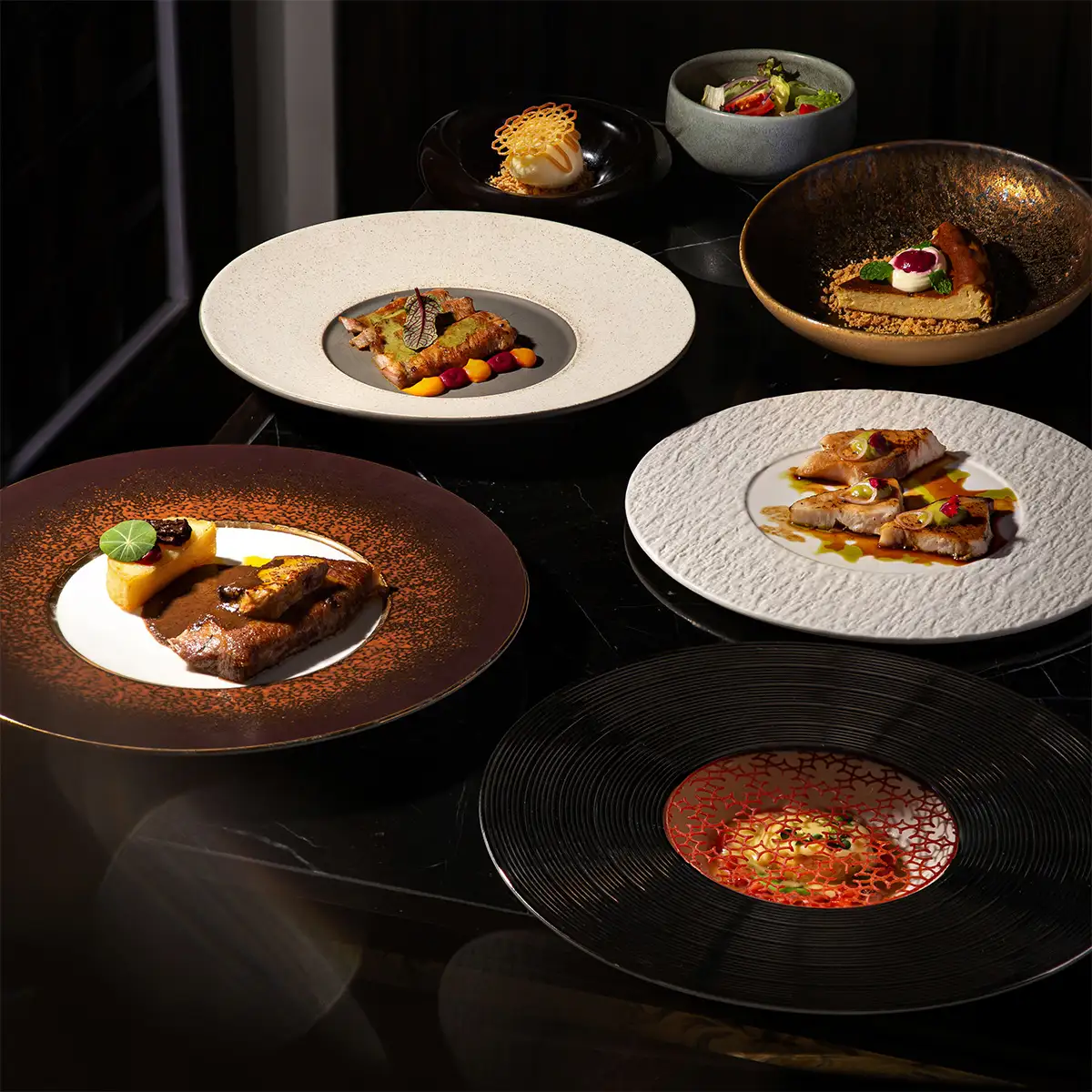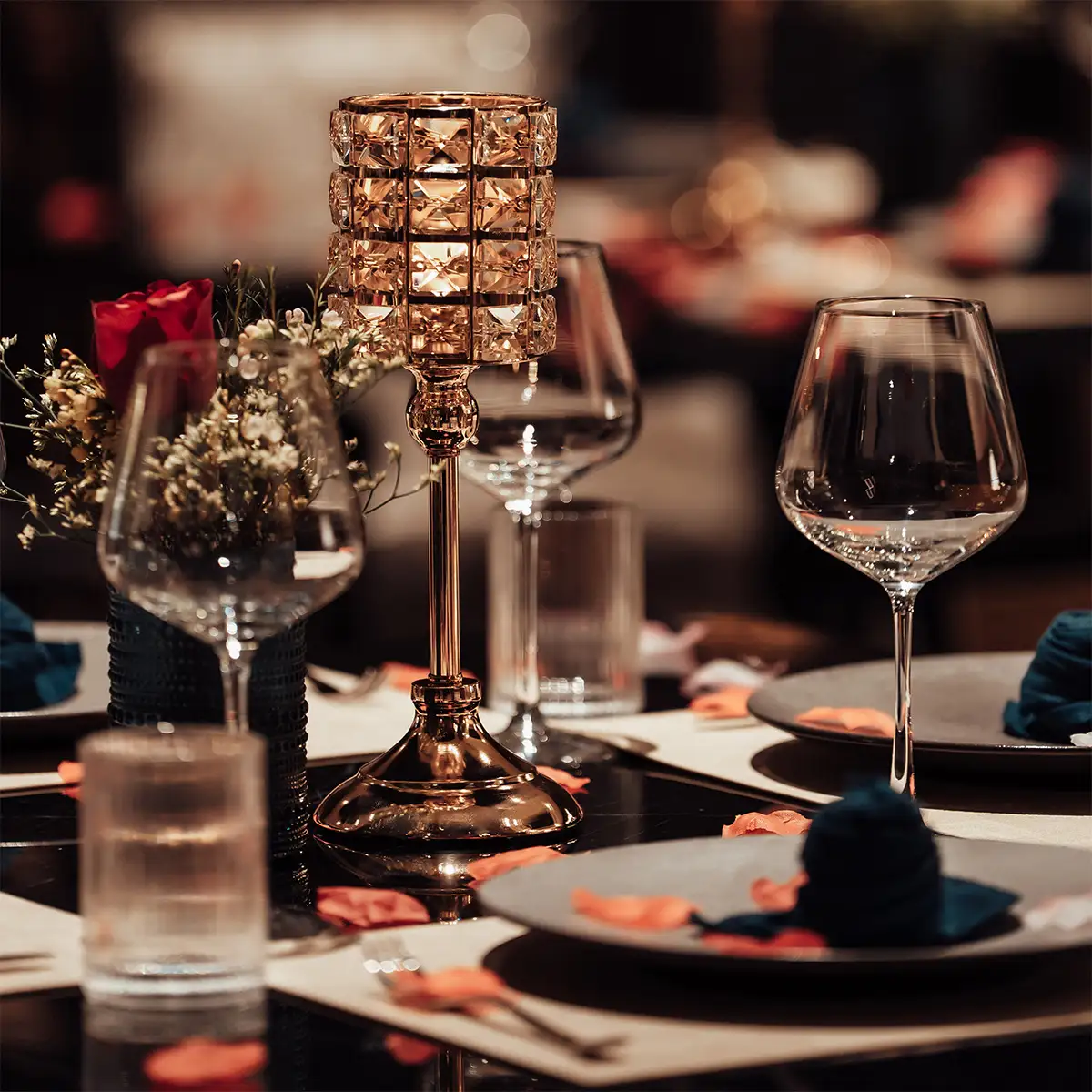Gastronomy has undergone a remarkable evolution, moving from simple sustenance to an art form. In modern society, fine dining occupies a special niche, offering not just meals, but curated experiences. However, the task of fine dining restaurant evaluation is a nuanced process. It demands an appreciation for a multitude of interconnected factors that contribute to the overall impression. This article aims to provide a thorough overview of the fine dining concept, detail the critical criteria for its evaluation, and proudly introduce Moca Dining as an exemplar in this distinguished category. Understanding how to approach fine dining restaurant evaluation will undoubtedly enhance your appreciation for these exceptional culinary havens.
1. The concept of fine dining
Fine dining is distinguished as a restaurant experience that is more sophisticated, distinctive, and typically more expensive than that found in a standard restaurant. It is an immersive experience characterized by exceptional food, meticulous service, and an upscale ambiance.
The history of fine dining can be traced back to ancient civilizations where communal feasting and elaborate rituals were integral to social and cultural life. However, the precursor to modern fine dining began to take shape in France around the 1780s. Influential figures like Auguste Escoffier later revolutionized the culinary world, codifying cooking techniques and kitchen organization, which became foundational to haute cuisine. The 20th century saw fine dining transcend French borders, adapting to regional tastes and influences globally.
The defining characteristics of a fine dining restaurant are multi-faceted:
- Luxurious and sophisticated ambiance: This includes elegant decor, curated interior design, comfortable seating, soft lighting, and often, background music to create a refined atmosphere.
- High-quality dishes, fresh ingredients, creative presentation: Menus are typically sophisticated and curated, focusing on premium, often locally-sourced or seasonal ingredients. Dishes are complex, requiring skilled chefs, and presentation is an art form.
- Professional and attentive service: Staff are highly trained, knowledgeable about the menu and wine pairings, and provide personalized, anticipatory yet unobtrusive service.
- Prices commensurate with quality: The higher price point reflects the superior quality of food, the intricacy of preparation, the exceptional service, and the overall luxurious experience.
Examples of famous fine dining restaurants around the world include establishments known for their avant-garde cuisine, exceptional service, and unique culinary visions. In Vietnam, esteemed venues showcase the country's burgeoning fine dining scene. Moca Dining in Hanoi is also recognized as a destination to enjoy cuisine as an artistic journey.
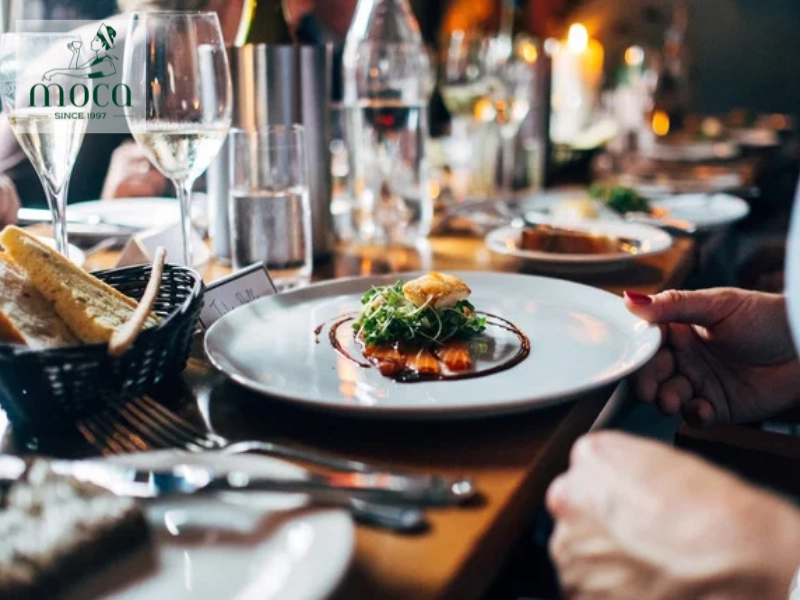
An elegant fine dining experience: where cuisine meets art and ambiance.
Learn more: Fine Dining Restaurant Decoration: Secrets to Creating a Luxurious & Upscale Ambiance
2. Criteria for evaluating a fine dining restaurant
A comprehensive fine dining restaurant evaluation hinges on several key criteria. Each element contributes significantly to the overall judgment and appreciation of the establishment. To truly evaluate a fine dining restaurant effectively, one must consider the harmonious interplay of these factors. The process to appraise a fine dining restaurant is thus a detailed examination of its core components.
Food quality: The cornerstone of excellence
The heart of any fine dining experience is, undeniably, the food.
- Ingredients: Freshness, origin. The use of high-quality, fresh, and often seasonal ingredients is paramount. The provenance of ingredients, such as locally sourced produce or ethically raised meats, can significantly elevate a dish. Discerning chefs understand that superior ingredients are the foundation of exceptional cuisine.
- Cooking techniques: Chef's sophistication and creativity. Mastery of culinary techniques, from classic methods to innovative approaches, showcases the chef's skill. Creativity in combining flavors and textures is a hallmark of a leading fine dining kitchen.
- Flavor: Balance and harmony of ingredients. Ultimately, the taste is what lingers. Dishes should exhibit a balance of flavors – sweet, sour, salty, bitter, and umami – with no single element overpowering others. The harmony of ingredients working together to create a cohesive and delightful palate experience is crucial.
- Presentation: Aesthetics and artistry. We eat with our eyes first. The visual appeal of a dish, including its color, shape, and arrangement on the plate, is a vital aspect of the fine dining experience. It reflects the chef's attention to detail and artistic vision.

A harmony of taste, technique, and artistry on every plate.
Service: The art of hospitality
Exceptional service is a non-negotiable component when you evaluate a fine dining restaurant.
- Service attitude: Professionalism, politeness, attentiveness. Staff should be welcoming, courteous, and anticipate guests' needs without being intrusive. A respectful and polished demeanor is expected.
- Knowledge of food and drinks: Ability to advise and answer questions for customers. Servers should possess a thorough understanding of the menu, including ingredients, preparation methods, and potential allergens. Sommeliers, if present, should offer expert wine pairing advice.
- Speed of service: Ensuring comfort, without causing discomfort to customers. Service should be efficient and timely, with courses paced appropriately to allow guests to savor the meal without feeling rushed or unduly delayed.

Graceful service: where professionalism meets personalized care.
Atmosphere: Crafting the environment
The ambiance significantly shapes the dining experience and is a critical factor when you appraise a fine dining restaurant.
- Design: Aesthetics, harmony, creating a relaxing feeling. The interior design, including furnishings, artwork, and table settings, should be elegant, cohesive, and contribute to a sense of comfort and sophistication.
- Lighting, music: Creating an atmosphere suitable for the restaurant's style. Lighting should be carefully considered to create the desired mood – often soft and warm for intimacy. Music, if present, should complement the ambiance and be at a volume that allows for easy conversation.
- Hygiene: Ensuring cleanliness and tidiness. Impeccable cleanliness throughout the restaurant, from the dining room to the restrooms, is fundamental.
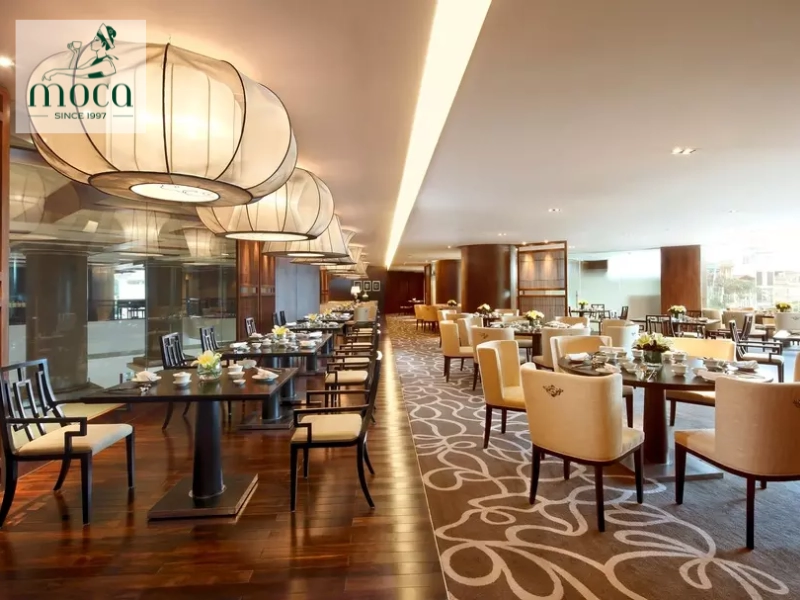
An elegant ambiance that soothes the senses and elevates the experience.
Price: Reflecting value
The cost is an inevitable part of the fine dining restaurant evaluation.
- The correspondence between price and quality of food, service, and atmosphere. Prices in fine dining are expected to be higher, but they must be justified by the overall quality of the experience – the excellence of the ingredients, the skill of the chefs, the professionalism of the service, and the luxury of the environment. Patrons expect a premium for the entire experience.
Other factors: The nuances of distinction
Beyond the primary criteria, other elements contribute to a comprehensive appraisal of a fine dining restaurant.
- Reputation of the restaurant and chef. A strong reputation, often built over years of consistent excellence and possibly recognized by culinary awards or guides, enhances a restaurant's standing.
- Uniqueness and creativity in the menu. A menu that showcases originality, innovative dishes, or a distinctive culinary vision sets a restaurant apart.
- Ability to meet special customer requirements (e.g., allergies, dietary restrictions). A willingness and capability to accommodate guests' special dietary needs with grace and culinary skill is a mark of a truly guest-focused fine dining establishment.

A premium experience where every detail justifies the price.
Learn more: Fine Dining Etiquette: Secrets to Elegant Manners & Experiences
3. Introducing Moca Dining restaurant
Moca Dining stands as a distinguished presence in Hanoi's culinary landscape, offering an experience that epitomizes the essence of fine dining. Our history is rooted in a passion for culinary artistry and a commitment to providing an unparalleled guest journey. The culinary style at Moca Dining is a sophisticated fusion, harmoniously blending the rich traditions of Vietnamese cuisine with global gastronomic influences, resulting in a menu that is both innovative and deeply satisfying. The atmosphere is one of understated luxury and warmth, designed to make every visit a memorable occasion. When you evaluate a fine dining restaurant like Moca Dining, you'll find a commitment to excellence in every detail.
- Diverse and creative menu, harmoniously combining Vietnamese and international cuisine: Our chefs take pride in crafting dishes that surprise and delight, offering a unique fine dining adventure.
- Fresh, high-quality ingredients, carefully selected: We believe that exceptional meals begin with exceptional ingredients, sourced for their peak freshness and superior quality. This is a cornerstone of how one should appraise a fine dining restaurant.
- Talented and experienced team of chefs: Our culinary brigade is composed of passionate professionals dedicated to the art of cooking, bringing both innovation and precision to every plate.
- Luxurious and cozy space, bearing the hallmarks of ancient French architecture: As previously described, our ambiance is designed to be both elegant and welcoming, providing the perfect setting for a sophisticated dining experience.
To truly evaluate a fine dining restaurant, one must experience it. At Moca Dining:
Analyze some of the signature dishes on the menu:
- Dry-Aged Duck Breast, elevated. This classic dish is reimagined with premium, carefully dry-aged duck breast, expertly seared to enhance its rich flavor and tender texture, served with seasonal vegetables and a refined sauce, presented with contemporary flair.
- Imported Wagyu Ragu Tagliatelle. A testament to our international offerings, this dish features top-grade Wagyu, cooked to perfection, and complemented by a uniquely Vietnamese peppercorn sauce that adds a local aromatic zest.
Our service team is trained to be attentive yet discreet, ensuring every need is met with professionalism and warmth. The atmosphere, as detailed earlier, provides a backdrop of refined elegance, contributing significantly to the overall fine dining restaurant evaluation.
As a representative of Moca Dining, I can attest to the profound satisfaction derived from witnessing guests immerse themselves in the culinary journey we offer. There is a distinct pleasure in knowing that every element, from the first amuse-bouche to the final petit four, has been thoughtfully curated to create moments of delight and lasting memories.
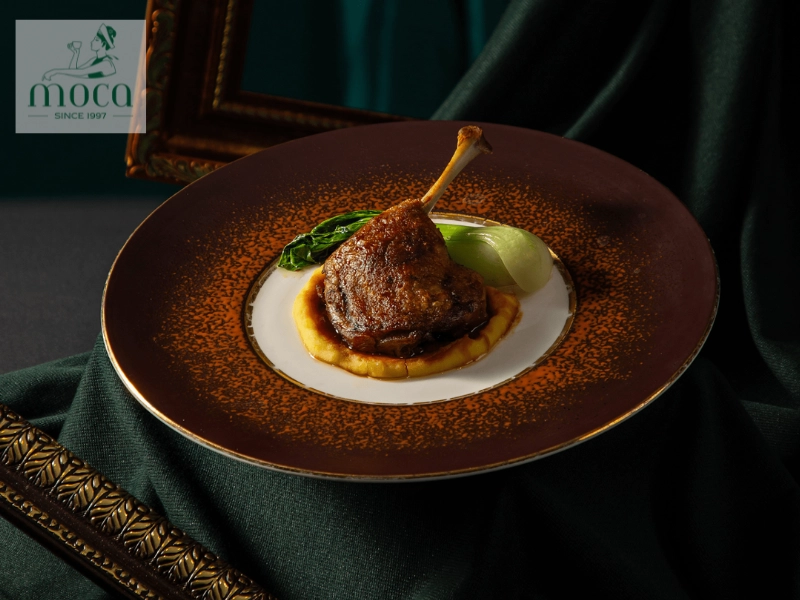
Moca Dining — where Vietnamese soul meets global elegance in every dish.
For reservations and inquiries, please contact Moca Dining:
Address: 16 Nha Tho, Hang Trong Ward, Hoan Kiem District, Hanoi
Phone: 0819961997
Website: https://mocadining.com/
Opening Hours: Monday to Sunday: 10:00 - 14:00, 18:00 - 22:00
4. Notes when dining at a fine dining restaurant
To fully appreciate and make the most of your experience, consider these suggestions:
- Find out in advance about the restaurant: style, menu, prices. A little research helps set expectations and allows you to anticipate the culinary journey.
- Book in advance, especially on holidays and weekends. Fine dining restaurants often have limited seating and are in high demand.
- Dress politely, suitable for the restaurant's space. While not all fine dining establishments have strict dress codes, opting for smart, elegant attire shows respect for the ambiance and the efforts of the restaurant.
- Master the rules of etiquette at the table. Familiarize yourself with basic fine dining etiquette, such as napkin placement, utensil usage, and polite conversation. For example, wait for all guests to be served before beginning to eat.
- Enjoy the food slowly and delicately. Savor each course, paying attention to the flavors, textures, and presentation. Fine dining is an experience to be relished, not rushed.
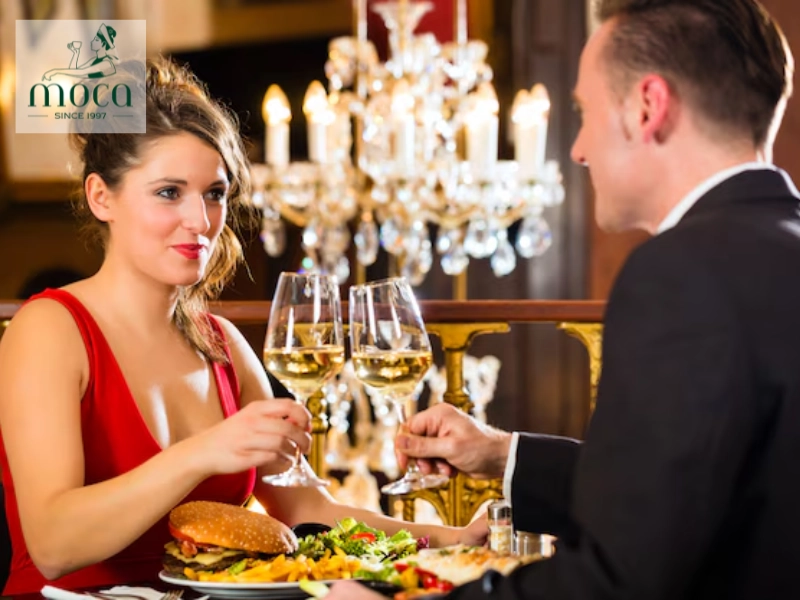
Fine dining etiquette: respect the setting, savor the experience.
Fine dining is a sophisticated experience that blends exceptional cuisine, impeccable service, captivating atmosphere, and overall value. A thorough fine dining restaurant evaluation helps deepen appreciation by recognizing how these elements work in harmony to transform a meal into a cherished memory. We warmly invite you to Moca Dining to experience firsthand the passion, precision, and hospitality that define a truly remarkable fine dining restaurant.






